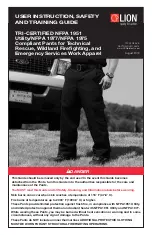
9
5.
CONSTRUCTION, FEATURES AND FUNCTION
In order to understand the limits of protection provided by your NFPA 1951 Utility/NFPA 1977/
NFPA 1975 Tri-Certified Pants, you should study its construction, features, and function.
5.1 OVERVIEW
Your Pants helps reduce health and safety risks to the Technical Rescue and/or
Wildland Firefighter. It protects the responder because it is made of special heat
and flame resistant textiles which when exposed to flash fire, char instead of melt
or combust, thereby reducing further injuries that can be caused by the ignition of
the materials. Second, the thickness of the fabrics also creates limited insulation
which contributes to the limited protection to the wearer against heat and flame
associated with flash fire.
Your Garment is designed to meet the requirements of NFPA 1975, NFPA 1977,
and
ONLY the Utility
requirements of NFPA 1951.
5.2
IMPORTANT SAFETY FEATURES
Closure System:
On the front of the Pants, when properly fastened, prevent
the Pants from coming open during Technical Rescue and/or Wildland
Firefighting activities.
Pockets:
Provide storage for tools.
Reinforcements:
Provide reinforcement at the knees and seat against heat and
flame, cuts and abrasion.
Labels:
There are three (3) important safety, cleaning, and information labels, all
located on the inside of the Pants. The Pants Safety Label provides critical safety
information and directs you to read and understand this Guide. The Cleaning Label
explains washing, drying and storage instructions.
In addition, the Pants Information Label, located on the centre back inside the
garment lists the Pants model and the date of manufacture.
Samples of the labels are located on page 2 of this Guide
You must wear an ANSI 107 or ANSI 207-compliant high visibility vest at all times during any emergency
operation near roads or highways, unless you are actively engaged in fire suppression or hazardous
materials mitigation, during which you must also wear the full ensemble of certified, task-appropriate
protective clothing. The high visibility vest’s retroreflective trim and fluorescent material increase your
likelihood of being seen by motorists and thereby decreases the probability of injury.
!
WARNING
6. INSPECTION
6.1 PREPARATION
Read all labels first. There are three Safety, Cleaning and Information Labels
(See Section 5 of this Guide for location). If any of the labels are missing, return
the Pants to the manufacturer immediately.
6.2 FREQUENCY
You should inspect your Pants at the following times: 1.) Upon receipt of your
new Pants or replacement component; 2.) At least monthly thereafter during
the useful life of the Pants; 3.) After exposure to heat, flames, chemicals; and
4.) After washing, repair or decontamination. You must inspect your Pants as
a minimum, at the above frequency intervals to detect more obvious damage
and deterioration. Whenever you detect a potential problem through your own
inspection, or suspect that the protective qualities might be degraded, your
Pants should be inspected by a trained expert at the Fire Department, a LION
TotalCare
®
Center, or factory designated facility.
Summary of Contents for NFPA 1975
Page 22: ...22 NOTES...
























